I've just got back from a cannon-netting trip to Guernsey, where we fitted colour rings to over 900 Herring and Lesser Black-backed Gulls on the tip there — actually somewhat stinkier than Pitsea Tip in Essex! More on this trip later, but it was an excellent opportunity to read some colour rings, and over three days we read rings on over 270 individuals. Many were local, but they also included birds from Jersey, France and one of our own birds from Pitsea Tip! This got me thinking...
Whether you've been scanning through Black-wits in Hampshire, throwing chips to Med Gulls on Great Yarmouth seafront or twitching any of the Glossy Ibis of recent years, I'm sure that most people reading this article will have at some point seen a bird carrying colour rings. But did you note it down and report it?
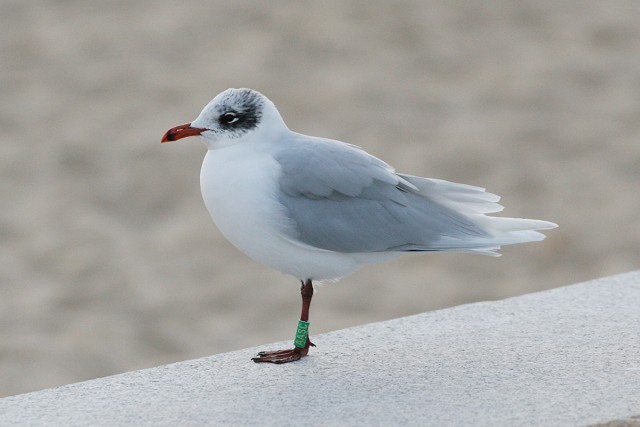
German-ringed Mediterranean Gull, Great Yarmouth, Norfolk (Photo: Mark Pearson)
It often surprises me how infrequently colour-ringed birds are reported, and I've never quite figured out why this might be. To a degree I think there will always be the "someone will have reported it already" mindset, but hopefully I can help to turn that around.
The basic premise of colour-ringing is that you remove the need to recapture birds, as they are individually identifiable in the field. For some species there is also the added advantage that birds that are impossible to recapture as adults can still be followed. So at any time there will be colour-ringing projects running on a huge variety of species, and for an equally varied number of reasons.
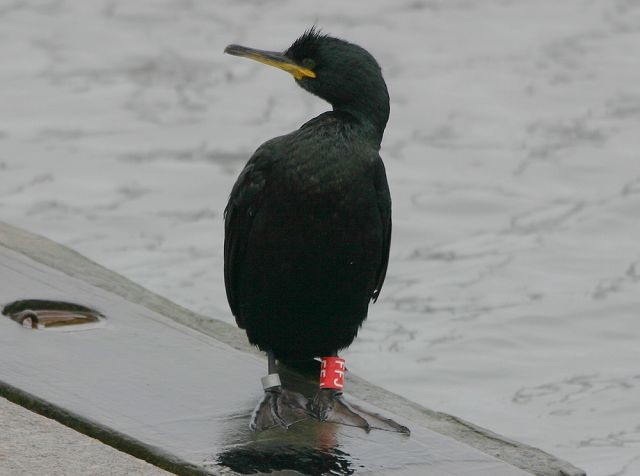
Twelve-year-old Isle of May Shag, Scarborough, North Yorkshire (Photo: Dave Mansell)
So what do we find out from colour-ringing?
In the main, colour-ringing studies are about investigating life-histories: movements, survival and behaviour.
For example, colour-ringing of over 2,000 Twite from two populations — those breeding in the south Pennines and those wintering in northwest England — has shown the different strategies these populations adopt. Breeding birds from the Pennines spend their winters along the east and southeast coasts of Britain, with very few moving to the west coast. In contrast, the majority of birds wintering on the Lancashire and Cumbria coasts breed on islands off the west coast of Scotland and on the Scottish mainland. However, a few of these northwest-wintering birds have also been seen, in the same winter or subsequently, on the coast of Lincolnshire. Two birds from the Pennines have also changed their allegiances, one breeding in Scotland and one halfway up Snowdon in Wales. So because there is little crossover between the populations, this project highlighted the need to protect these two populations in very different ways, helping in the formulation of species conservation plans. A similar project in Ireland has also revealed some interesting results, viewable online.
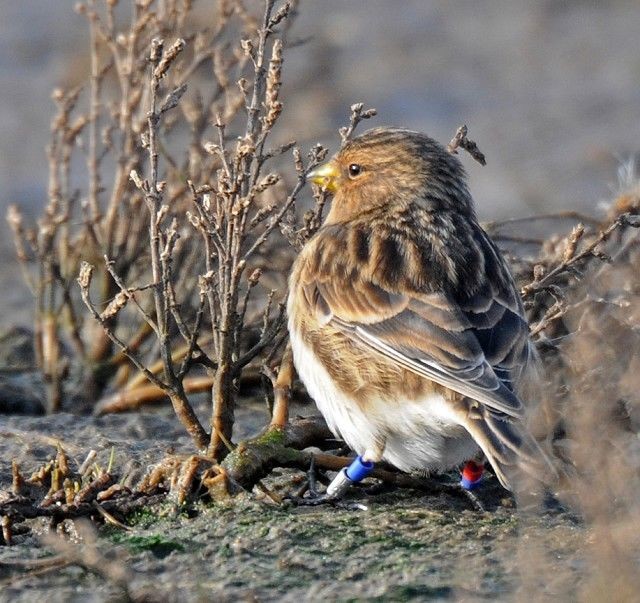
Twite, Dunwich Pools, Suffolk (Photo: Jon Evans)
Projects looking at the demography of populations also produce amazing results. Recent work on Blackbirds in an urban Norfolk garden has shown that survival varies greatly by month, being lowest during the early spring period, rather than the more-expected winter period. There were also interesting trends in survival between the sexes (though not significant), with male survival lower during the early spring, presumably when they're spending more time defending territories than paying attention to traffic!
Multiple reports of birds are also of great use, as they help us understand turnover rates and site fidelity. This Sanderling was ringed in Iceland in May 2009, where it was seen on a further further eight dates. It was then seen on St Mary's Island (Northumberland) on 9 September 2009 and reported on a further seven dates in roughly the same area up to 10 March 2010.
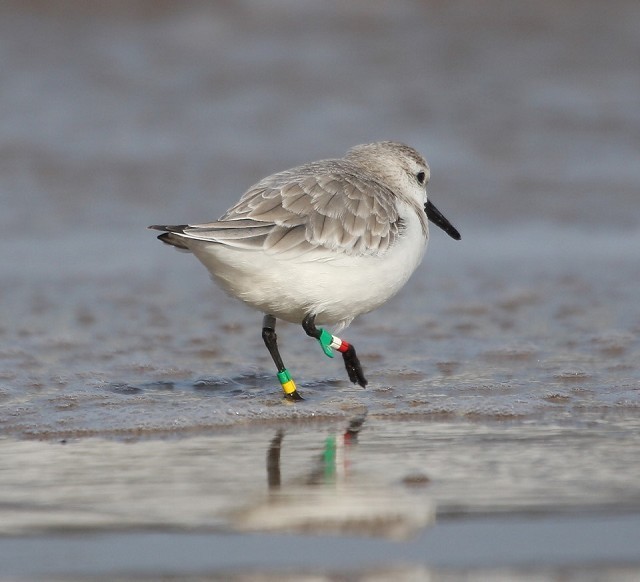
Sanderling, St. Mary's Island, Northumberland (Photo: Alan Tilmouth)
There are then many more projects, including:
- Studies of feral populations of birds, such as Barnacle Goose — check the BTO's post on 'Demog Blog' for more details
- Monitoring the progress of reintroduction programmes, such as the wing-tagging of Red Kites and White-tailed Eagles
- International flyway projects looking at movements of Black-tailed Godwits between their Icelandic breeding areas and wintering sites in Western Europe.
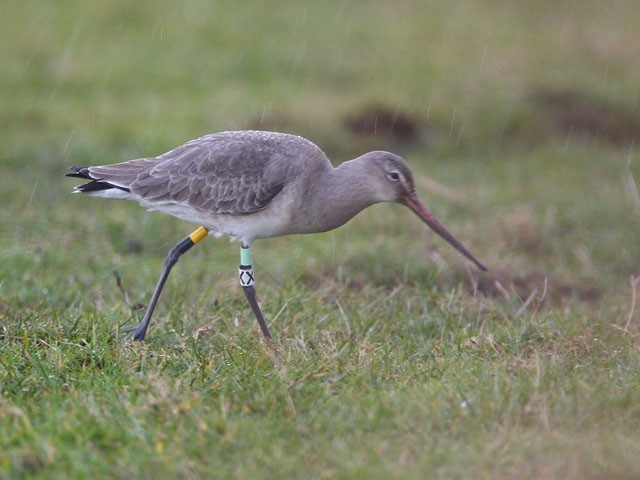
Black-tailed Godwit, Moreton, Cheshire (Photo: Philip Price)
What groups of birds are colour-ringed?
The range of colour-ringing projects is huge, from small passerines carrying individual combinations of coloured rings to geese with inscribed neck-collars and raptors with wing tags. But perhaps the most likely birds you will come across on your birding travels are:
- Black-tailed Godwits from the Icelandic breeding population
- Mediterranean Gulls from various projects across Europe
- Pied and White Wagtails from winter roosts in Devon and Stratchclyde
- Most of the large gull species will be colour-ringed somewhere in their range, so are worth checking. This Caspian Gull was originally ringed in southern Poland, and the Glaucous Gull was ringed as a chick on Bear Island in July 2008.
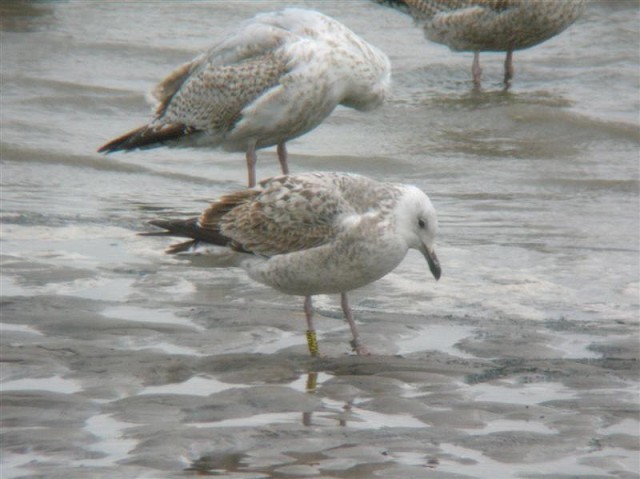
Caspian Gull, Richmond Bank, Cheshire (Photo: Gavin Thomas)
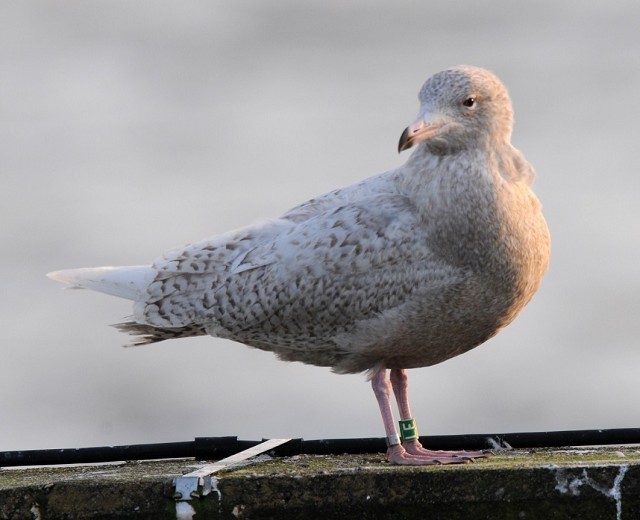
Glaucous Gull, Southwold, Suffolk (Photo: Jon Evans)
Why do I need to report colour rings on common birds?
It is often tempting to think that it isn't worth reporting rings from quite common species, but all records are incredibly important.
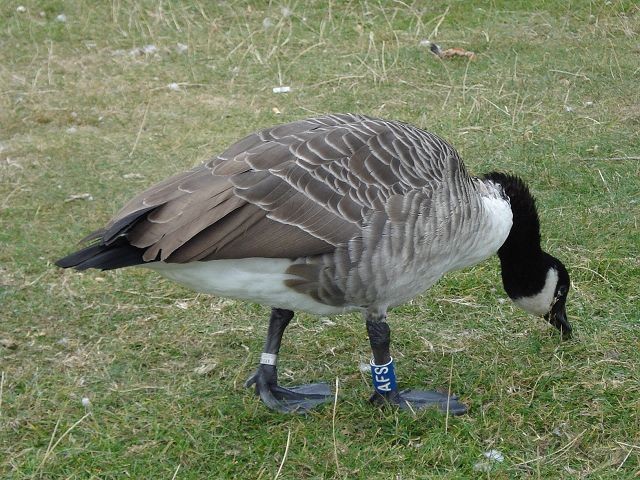
Canada Goose, Kensington Gardens, Greater London (Photo: Des McKenzie)
You never know where these common birds may be from anyway. This last winter has seen a run of reports of Greylag Geese in Norfolk with green neck collars. Nothing interesting there... however, these birds were actually ringed in Belgium as part of a large feral flock. A few years ago Norfolk also hosted a Greylag Goose from the population wintering in Spain, which breed in Scandinavia. These birds have gradually been abandoning their regular wintering sites (evident from reports of colour-ringed birds), so perhaps we are seeing a new trend here.
Winter Black-headed Gulls are always worth a look as well, with many originating from Scandinavia and the Baltic.
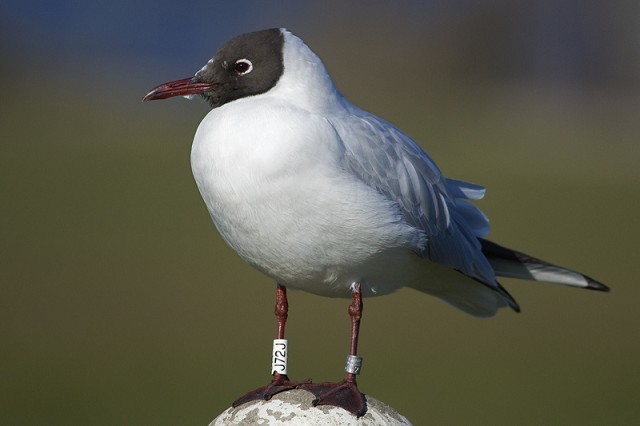
Norwegian-ringed Black-headed Gull, Amble, Northumberland (Photo: Tim Mason)
What sort of movements have colour-ringed birds made?
The list of impressive movements of colour-ringed birds would be a very long one, but the extremes include a wing-tagged Red Kite from Scotland seen on the Azores and an American-ringed Canada Goose in Scotland. Add to this the movements of Lesser Black-backed Gulls breeding in The Netherlands day-tripping the pig fields of East Anglia, and Glossy Ibis from Doñana teaming up with those from the Camargue in the recent influx, and there are a myriad stories to tell.
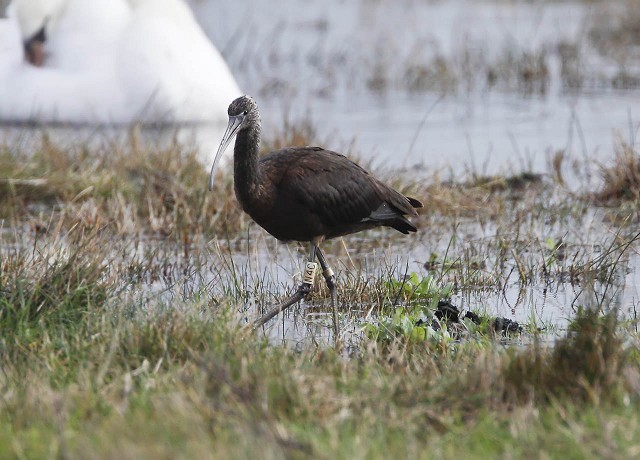
French-ringed Glossy Ibis, Catcott Lows NR, Somerset & Bristol (Photo: Michael Roberts)
This Turnstone was originally ringed (with just a BTO ring) on the Isle of Thanet (Kent) in March 1999. It was then recaught (as a breeding female) on its breeding grounds at Alert, Ellesmere Island (Canada) in July 1999, where it had its colour rings added. It was seen again at Alert in July 2000, and then back on the Isle of Thanet in September 2005, just 500m from where it was originally ringed! Where it had been for the intervening years is unknown, though rather intriguing. More histories of ringed and colour-ringed birds can be found on the Thanet website.
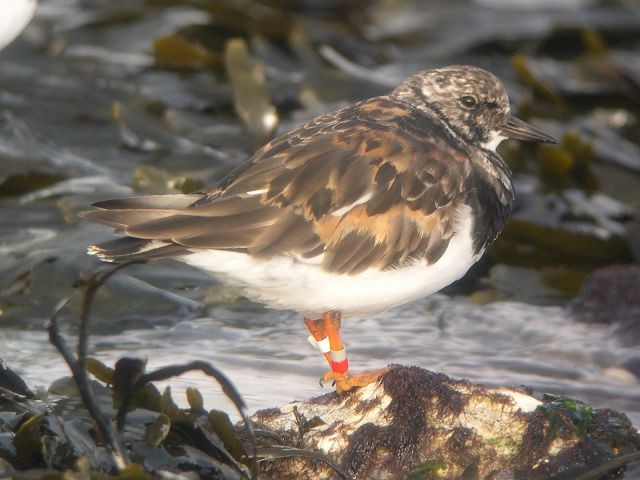
Turnstone, Foreness Point, Kent (Photo: Dylan Wrathall)
Why is it so hard to get details of colour-ringed birds?
Aside from aesthetics, one of the commonest queries about colour-ringing is the occasional difficulty and delay in receiving ringing details. This frustrates the various ringing centres as well, so you're not alone!
Some of the delay may be dictated by field seasons, with researchers working hard to get more rings on birds, often in inaccessible parts of the world. There is also the spectre of unregistered projects. It is relatively simple, for example only, for a student (not from Britain I might add) working on survival rates of Avocet chicks to receive permission to colour ring (and not necessarily metal ring) birds. Once their chicks have 'fledged' they really have little interest in their movements, and once their two or three years of fieldwork are over they have even less interest. However, these colour-ringed birds could then move anywhere in Europe, being seen and reported by birders, but will never be traced. Whilst this is only an example, Avocet was chosen for a reason, as this species alone has over 100 registered projects across Europe!
So all we ask is a little bit of patience...
Where should I report a colour-ringed bird?
In most cases, the best place to start tracing a colour-ringed bird will be on the excellent cr-birding website. Here you can scan the individual species projects across Europe and contact the project leader directly with details. This will often lead to a much quicker response.
Failing that, you can also report all colour-ringed (and metal-ringed) birds on the online EURING form at www.ring.ac. Details will then be passed to the relevant coordinator who will try to direct your sighting to the ringer involved.
Do remember, though, that many (if not most) coordinators are volunteers working in their spare time, so again, please be patient.
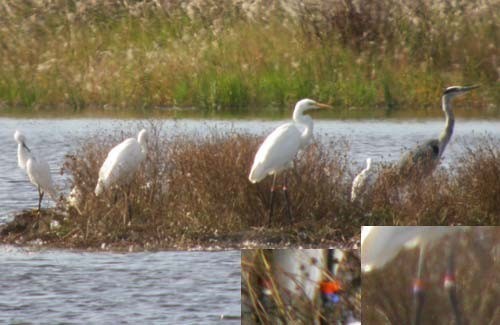
Great White Egret, Ouse Fen RSPB, Cambridgeshire (Photo: Richard Thomas)
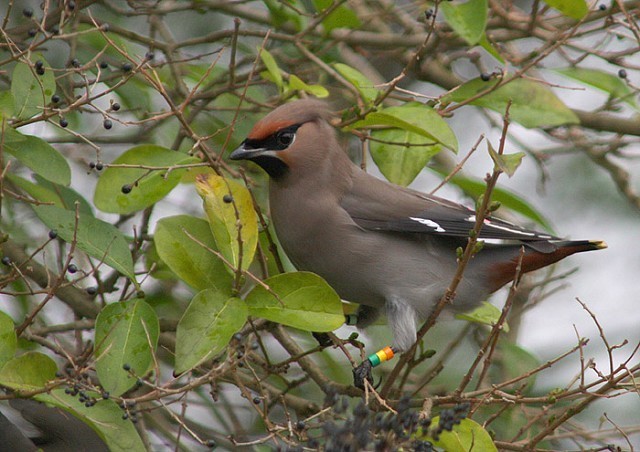
Waxwing, Bury, Greater Manchester (Photo: A. Dancy)

